Conflict Management and Employee Productivity: HSBC Australia Report
VerifiedAdded on 2020/04/01
|20
|4696
|153
Report
AI Summary
This report delves into the issue of workplace conflict within banking organizations, using HSBC Bank Australia as a primary example. It defines organizational conflicts, role conflicts, passive-aggressive behavior, and office romance, exploring their impact on employee performance and productivity. The report investigates how conflicts impede customer satisfaction, potentially leading to customer attrition and reduced revenue. A comprehensive literature review examines how conflicts hamper employee productivity, particularly in service sectors, and discusses the crucial role of apex management in conflict resolution. It presents findings from secondary information, including graphs from the Australian Statistical Bureau, and analyzes the relationship between conflict, employee productivity, and profitability. The report addresses research questions concerning the impacts of organizational conflicts, their effects on service sector companies, conflict management strategies, and the inhibition of customer satisfaction due to workplace conflicts, and concludes with a summary of the key findings and implications for banking organizations.
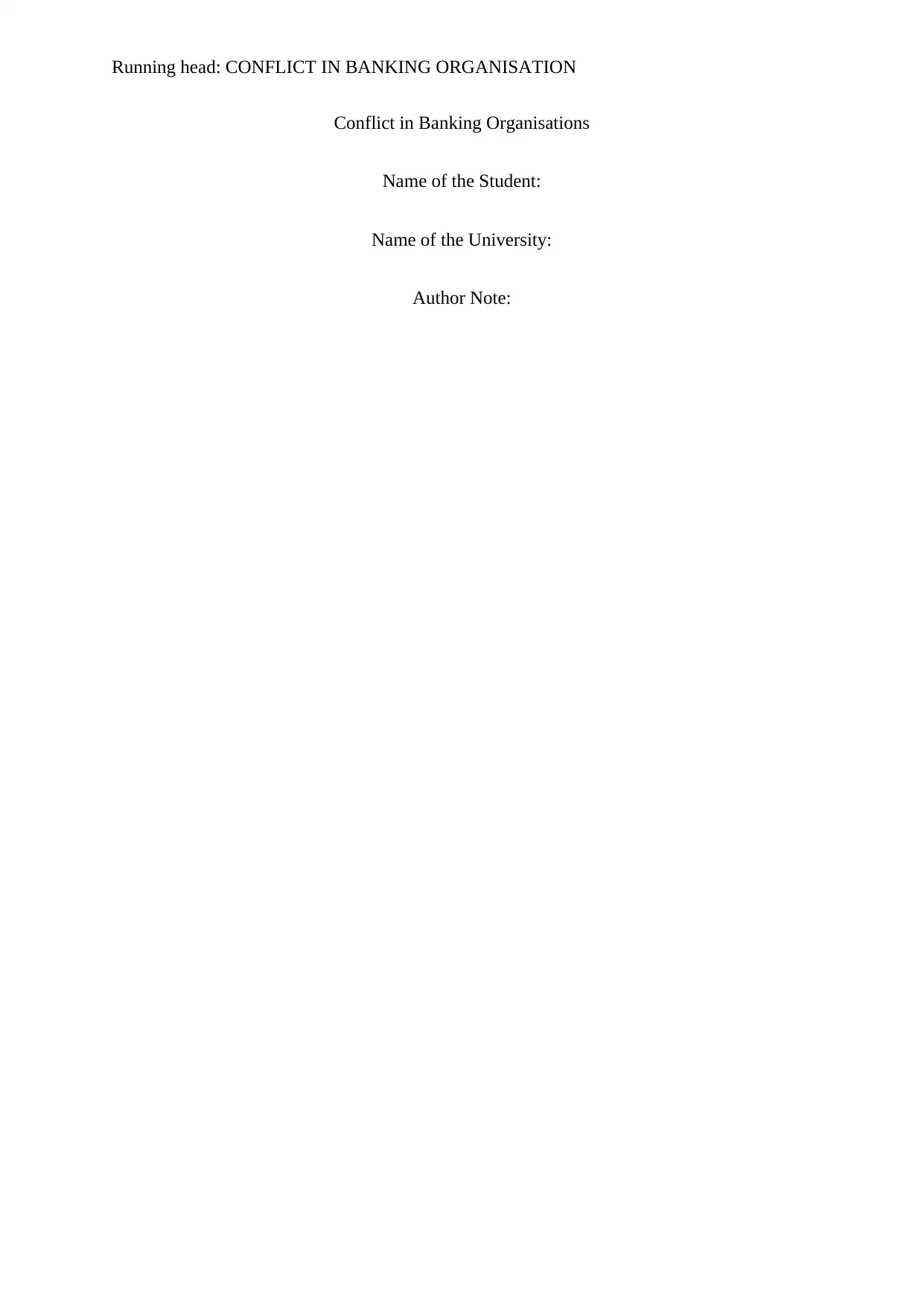
Running head: CONFLICT IN BANKING ORGANISATION
Conflict in Banking Organisations
Name of the Student:
Name of the University:
Author Note:
Conflict in Banking Organisations
Name of the Student:
Name of the University:
Author Note:
Paraphrase This Document
Need a fresh take? Get an instant paraphrase of this document with our AI Paraphraser
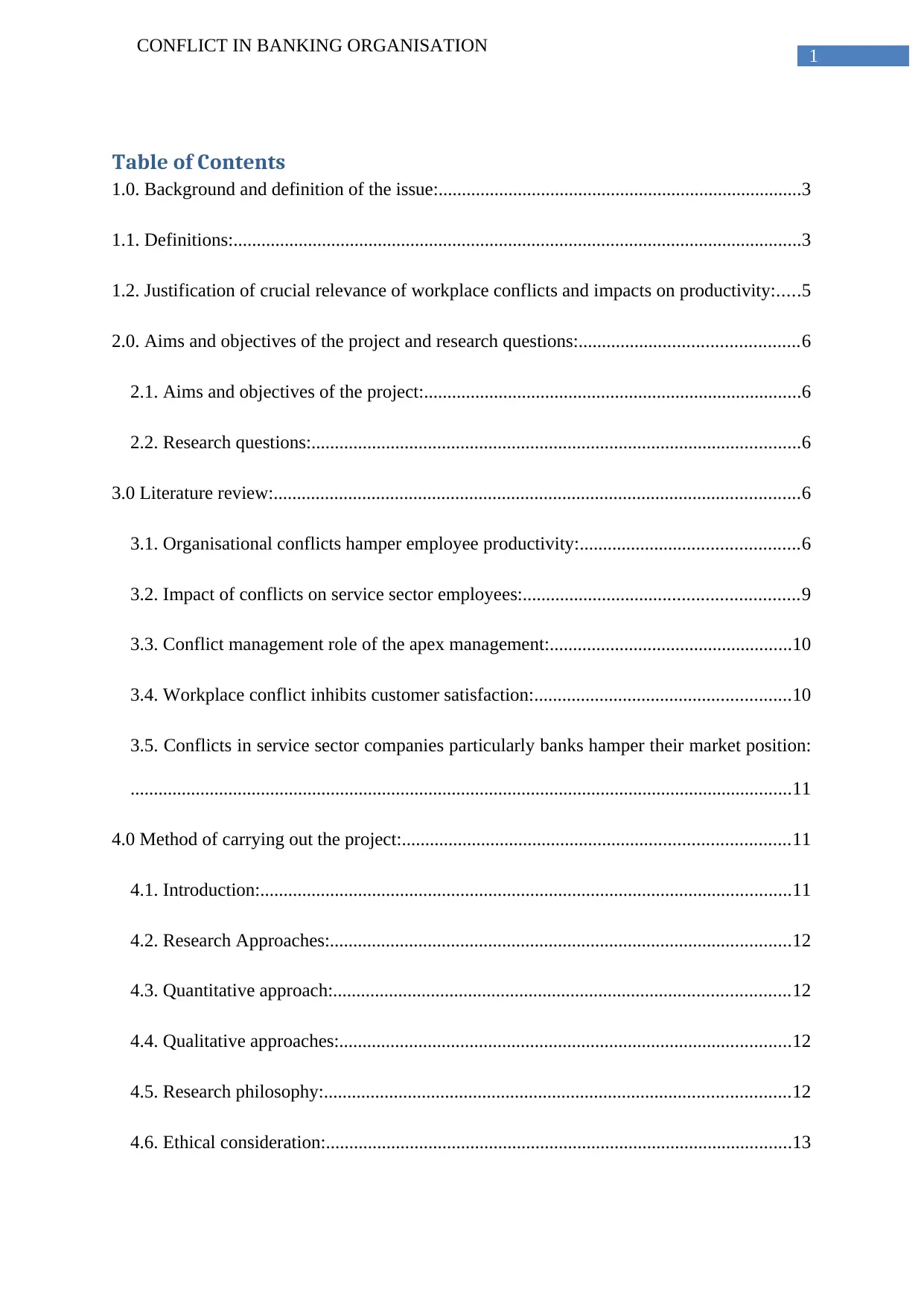
1
CONFLICT IN BANKING ORGANISATION
Table of Contents
1.0. Background and definition of the issue:..............................................................................3
1.1. Definitions:..........................................................................................................................3
1.2. Justification of crucial relevance of workplace conflicts and impacts on productivity:.....5
2.0. Aims and objectives of the project and research questions:...............................................6
2.1. Aims and objectives of the project:.................................................................................6
2.2. Research questions:.........................................................................................................6
3.0 Literature review:.................................................................................................................6
3.1. Organisational conflicts hamper employee productivity:...............................................6
3.2. Impact of conflicts on service sector employees:...........................................................9
3.3. Conflict management role of the apex management:....................................................10
3.4. Workplace conflict inhibits customer satisfaction:.......................................................10
3.5. Conflicts in service sector companies particularly banks hamper their market position:
..............................................................................................................................................11
4.0 Method of carrying out the project:...................................................................................11
4.1. Introduction:..................................................................................................................11
4.2. Research Approaches:...................................................................................................12
4.3. Quantitative approach:..................................................................................................12
4.4. Qualitative approaches:.................................................................................................12
4.5. Research philosophy:....................................................................................................12
4.6. Ethical consideration:....................................................................................................13
CONFLICT IN BANKING ORGANISATION
Table of Contents
1.0. Background and definition of the issue:..............................................................................3
1.1. Definitions:..........................................................................................................................3
1.2. Justification of crucial relevance of workplace conflicts and impacts on productivity:.....5
2.0. Aims and objectives of the project and research questions:...............................................6
2.1. Aims and objectives of the project:.................................................................................6
2.2. Research questions:.........................................................................................................6
3.0 Literature review:.................................................................................................................6
3.1. Organisational conflicts hamper employee productivity:...............................................6
3.2. Impact of conflicts on service sector employees:...........................................................9
3.3. Conflict management role of the apex management:....................................................10
3.4. Workplace conflict inhibits customer satisfaction:.......................................................10
3.5. Conflicts in service sector companies particularly banks hamper their market position:
..............................................................................................................................................11
4.0 Method of carrying out the project:...................................................................................11
4.1. Introduction:..................................................................................................................11
4.2. Research Approaches:...................................................................................................12
4.3. Quantitative approach:..................................................................................................12
4.4. Qualitative approaches:.................................................................................................12
4.5. Research philosophy:....................................................................................................12
4.6. Ethical consideration:....................................................................................................13
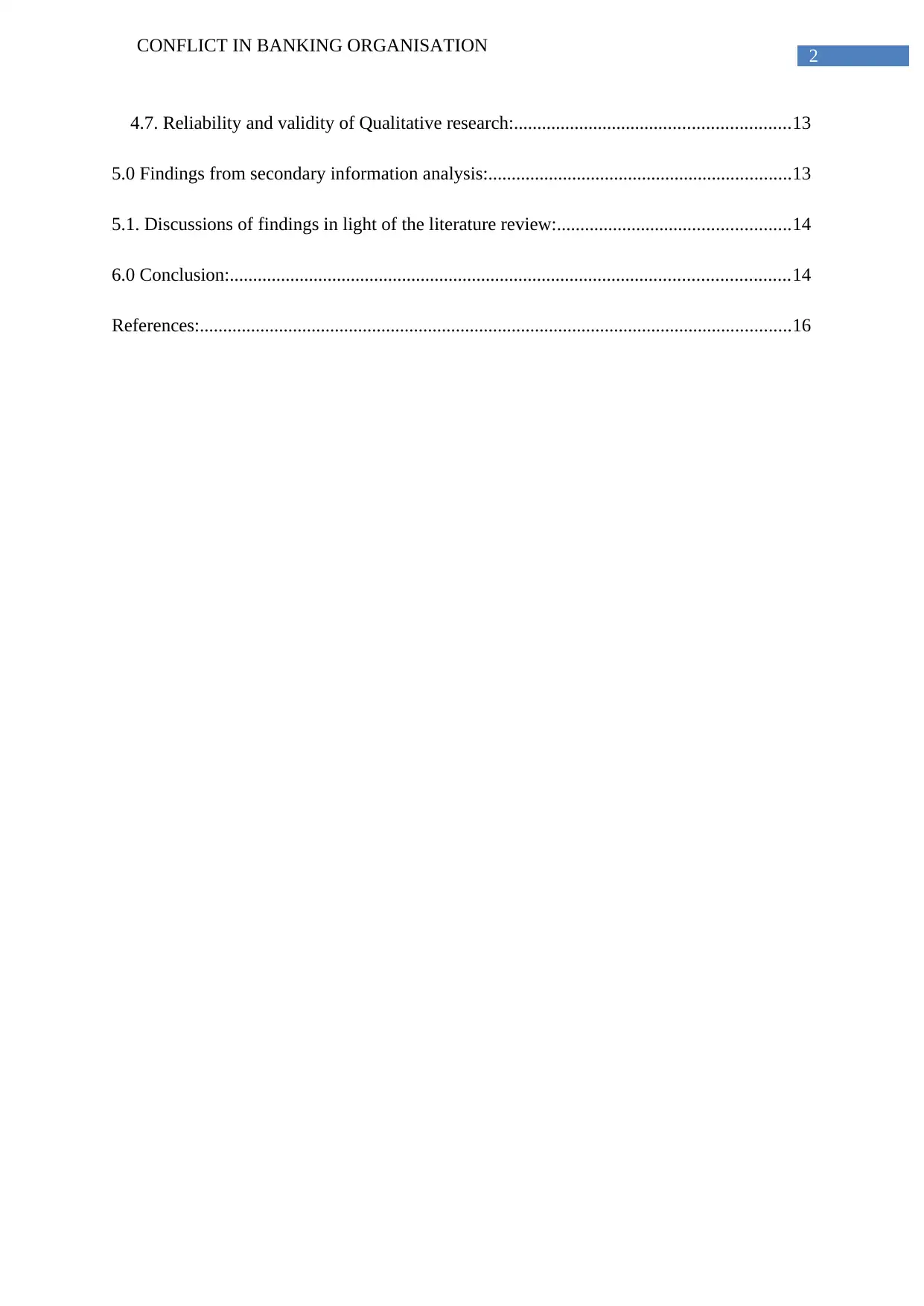
2
CONFLICT IN BANKING ORGANISATION
4.7. Reliability and validity of Qualitative research:...........................................................13
5.0 Findings from secondary information analysis:.................................................................13
5.1. Discussions of findings in light of the literature review:..................................................14
6.0 Conclusion:........................................................................................................................14
References:...............................................................................................................................16
CONFLICT IN BANKING ORGANISATION
4.7. Reliability and validity of Qualitative research:...........................................................13
5.0 Findings from secondary information analysis:.................................................................13
5.1. Discussions of findings in light of the literature review:..................................................14
6.0 Conclusion:........................................................................................................................14
References:...............................................................................................................................16
⊘ This is a preview!⊘
Do you want full access?
Subscribe today to unlock all pages.

Trusted by 1+ million students worldwide
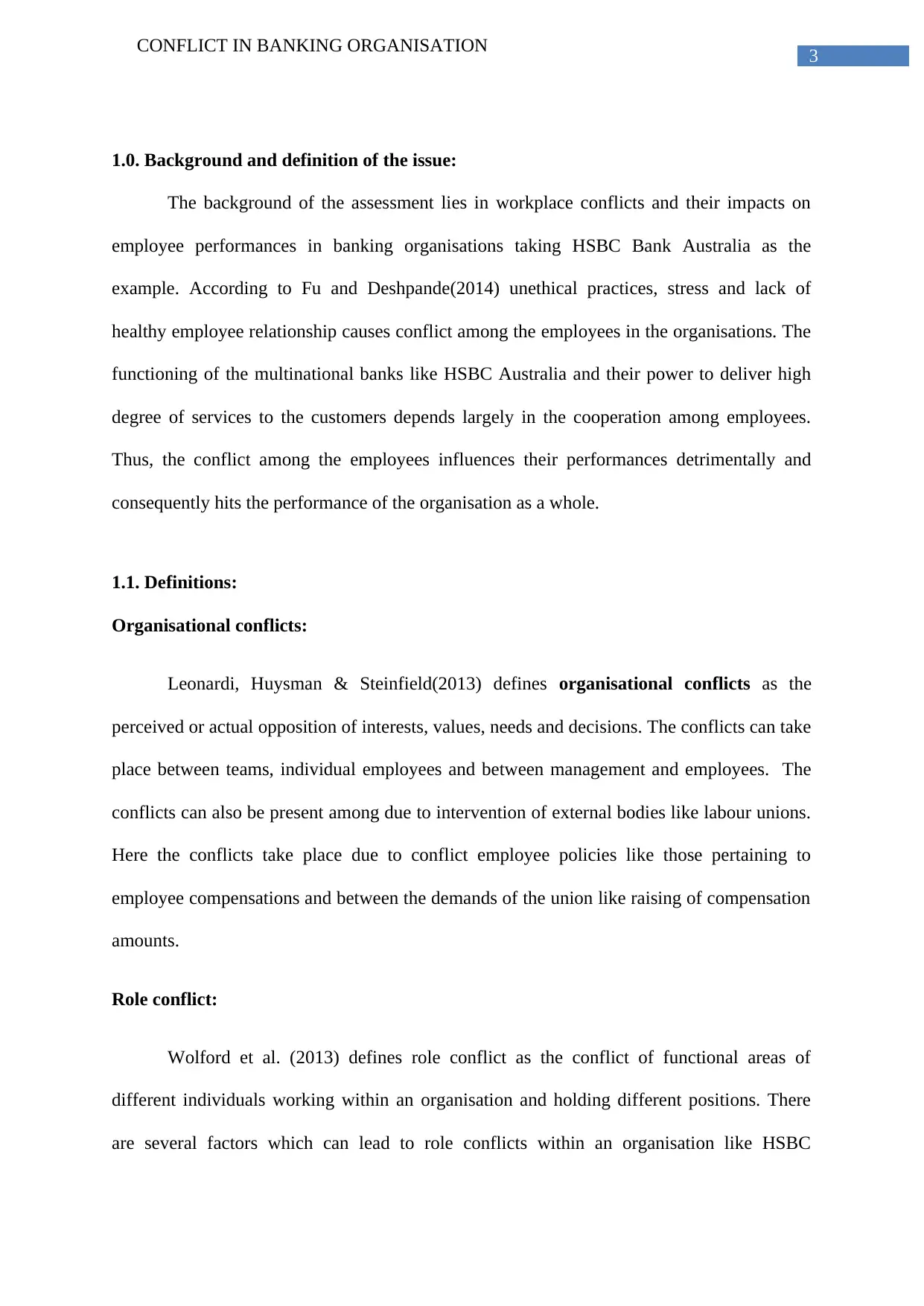
3
CONFLICT IN BANKING ORGANISATION
1.0. Background and definition of the issue:
The background of the assessment lies in workplace conflicts and their impacts on
employee performances in banking organisations taking HSBC Bank Australia as the
example. According to Fu and Deshpande(2014) unethical practices, stress and lack of
healthy employee relationship causes conflict among the employees in the organisations. The
functioning of the multinational banks like HSBC Australia and their power to deliver high
degree of services to the customers depends largely in the cooperation among employees.
Thus, the conflict among the employees influences their performances detrimentally and
consequently hits the performance of the organisation as a whole.
1.1. Definitions:
Organisational conflicts:
Leonardi, Huysman & Steinfield(2013) defines organisational conflicts as the
perceived or actual opposition of interests, values, needs and decisions. The conflicts can take
place between teams, individual employees and between management and employees. The
conflicts can also be present among due to intervention of external bodies like labour unions.
Here the conflicts take place due to conflict employee policies like those pertaining to
employee compensations and between the demands of the union like raising of compensation
amounts.
Role conflict:
Wolford et al. (2013) defines role conflict as the conflict of functional areas of
different individuals working within an organisation and holding different positions. There
are several factors which can lead to role conflicts within an organisation like HSBC
CONFLICT IN BANKING ORGANISATION
1.0. Background and definition of the issue:
The background of the assessment lies in workplace conflicts and their impacts on
employee performances in banking organisations taking HSBC Bank Australia as the
example. According to Fu and Deshpande(2014) unethical practices, stress and lack of
healthy employee relationship causes conflict among the employees in the organisations. The
functioning of the multinational banks like HSBC Australia and their power to deliver high
degree of services to the customers depends largely in the cooperation among employees.
Thus, the conflict among the employees influences their performances detrimentally and
consequently hits the performance of the organisation as a whole.
1.1. Definitions:
Organisational conflicts:
Leonardi, Huysman & Steinfield(2013) defines organisational conflicts as the
perceived or actual opposition of interests, values, needs and decisions. The conflicts can take
place between teams, individual employees and between management and employees. The
conflicts can also be present among due to intervention of external bodies like labour unions.
Here the conflicts take place due to conflict employee policies like those pertaining to
employee compensations and between the demands of the union like raising of compensation
amounts.
Role conflict:
Wolford et al. (2013) defines role conflict as the conflict of functional areas of
different individuals working within an organisation and holding different positions. There
are several factors which can lead to role conflicts within an organisation like HSBC
Paraphrase This Document
Need a fresh take? Get an instant paraphrase of this document with our AI Paraphraser
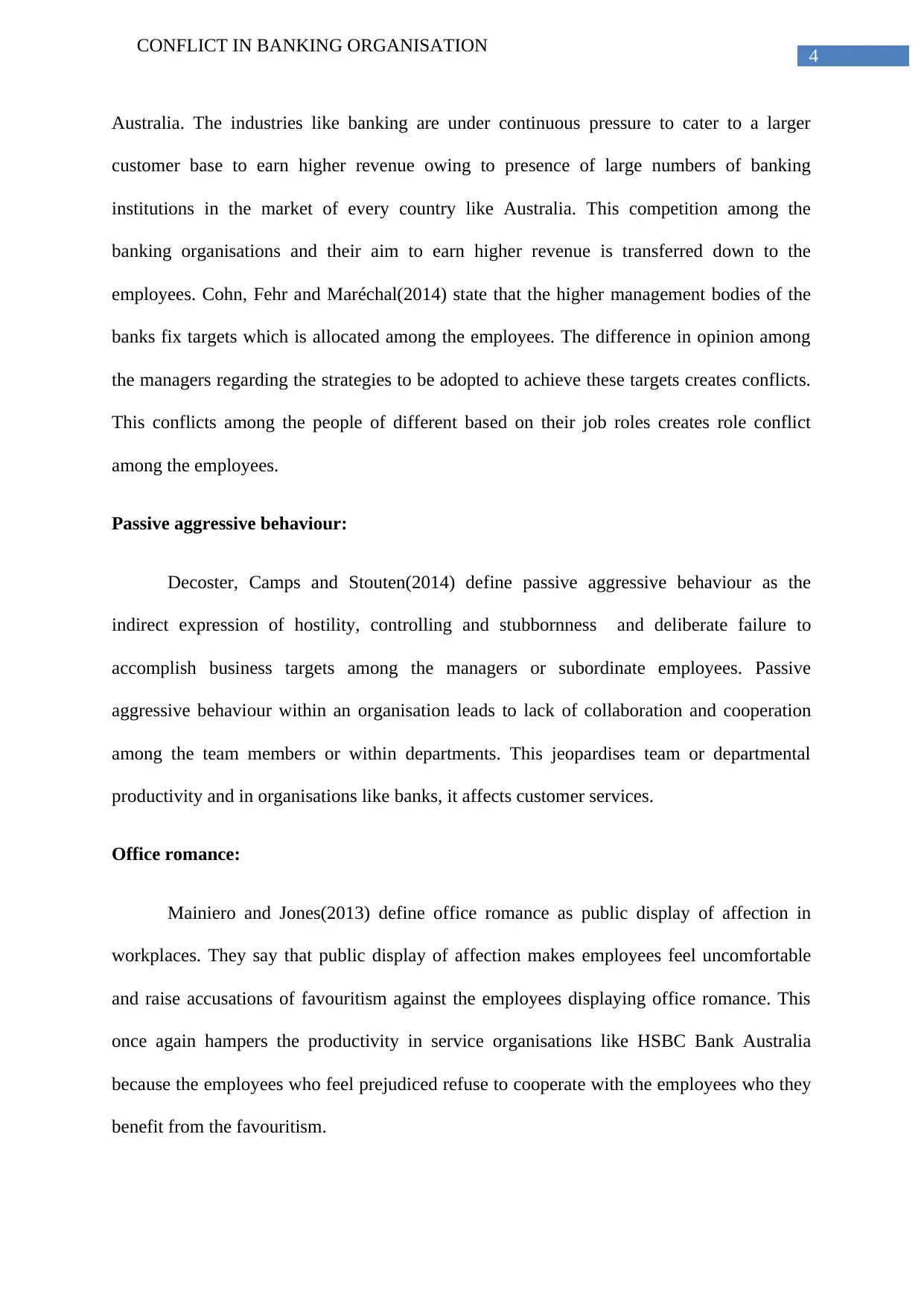
4
CONFLICT IN BANKING ORGANISATION
Australia. The industries like banking are under continuous pressure to cater to a larger
customer base to earn higher revenue owing to presence of large numbers of banking
institutions in the market of every country like Australia. This competition among the
banking organisations and their aim to earn higher revenue is transferred down to the
employees. Cohn, Fehr and Maréchal(2014) state that the higher management bodies of the
banks fix targets which is allocated among the employees. The difference in opinion among
the managers regarding the strategies to be adopted to achieve these targets creates conflicts.
This conflicts among the people of different based on their job roles creates role conflict
among the employees.
Passive aggressive behaviour:
Decoster, Camps and Stouten(2014) define passive aggressive behaviour as the
indirect expression of hostility, controlling and stubbornness and deliberate failure to
accomplish business targets among the managers or subordinate employees. Passive
aggressive behaviour within an organisation leads to lack of collaboration and cooperation
among the team members or within departments. This jeopardises team or departmental
productivity and in organisations like banks, it affects customer services.
Office romance:
Mainiero and Jones(2013) define office romance as public display of affection in
workplaces. They say that public display of affection makes employees feel uncomfortable
and raise accusations of favouritism against the employees displaying office romance. This
once again hampers the productivity in service organisations like HSBC Bank Australia
because the employees who feel prejudiced refuse to cooperate with the employees who they
benefit from the favouritism.
CONFLICT IN BANKING ORGANISATION
Australia. The industries like banking are under continuous pressure to cater to a larger
customer base to earn higher revenue owing to presence of large numbers of banking
institutions in the market of every country like Australia. This competition among the
banking organisations and their aim to earn higher revenue is transferred down to the
employees. Cohn, Fehr and Maréchal(2014) state that the higher management bodies of the
banks fix targets which is allocated among the employees. The difference in opinion among
the managers regarding the strategies to be adopted to achieve these targets creates conflicts.
This conflicts among the people of different based on their job roles creates role conflict
among the employees.
Passive aggressive behaviour:
Decoster, Camps and Stouten(2014) define passive aggressive behaviour as the
indirect expression of hostility, controlling and stubbornness and deliberate failure to
accomplish business targets among the managers or subordinate employees. Passive
aggressive behaviour within an organisation leads to lack of collaboration and cooperation
among the team members or within departments. This jeopardises team or departmental
productivity and in organisations like banks, it affects customer services.
Office romance:
Mainiero and Jones(2013) define office romance as public display of affection in
workplaces. They say that public display of affection makes employees feel uncomfortable
and raise accusations of favouritism against the employees displaying office romance. This
once again hampers the productivity in service organisations like HSBC Bank Australia
because the employees who feel prejudiced refuse to cooperate with the employees who they
benefit from the favouritism.
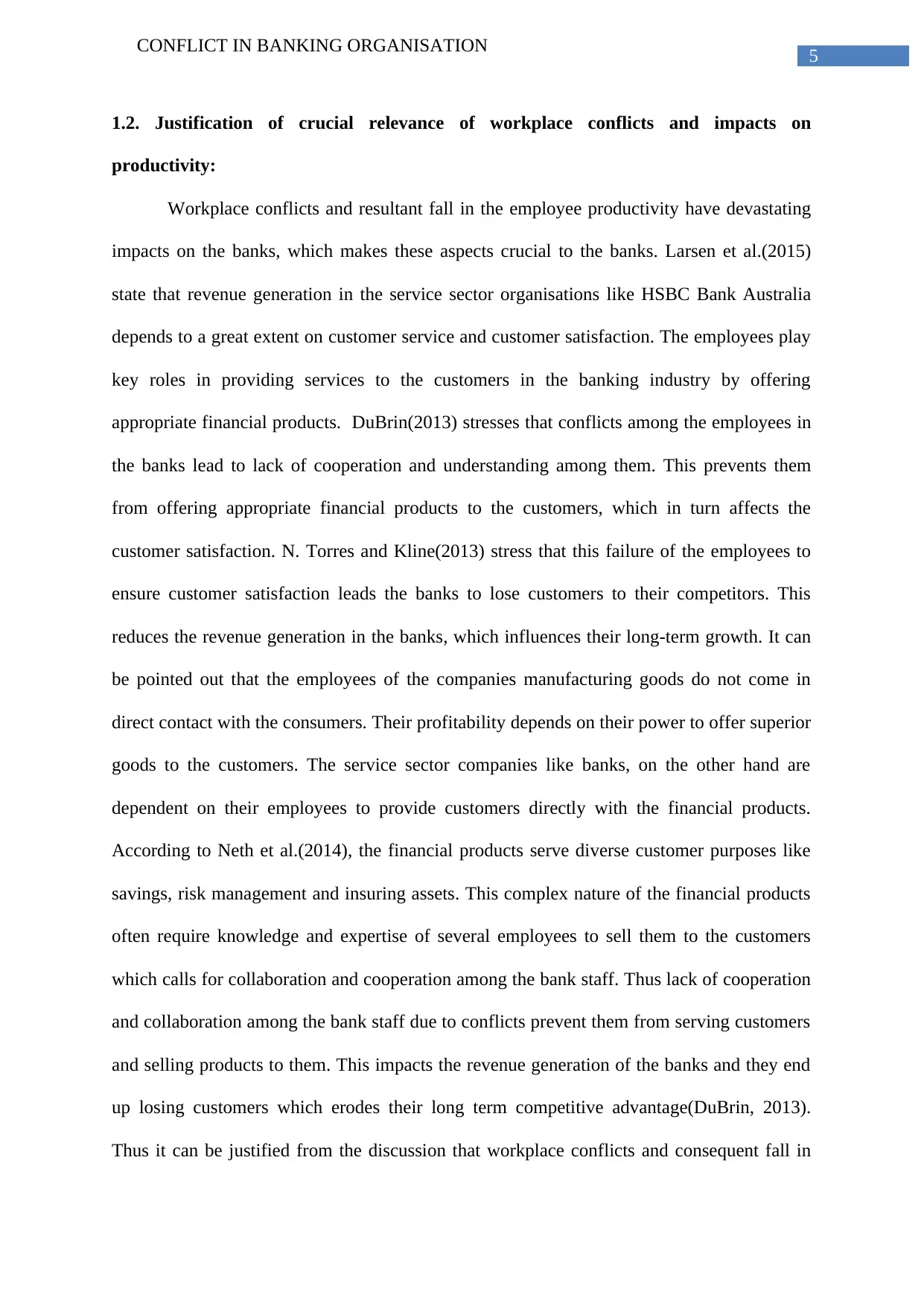
5
CONFLICT IN BANKING ORGANISATION
1.2. Justification of crucial relevance of workplace conflicts and impacts on
productivity:
Workplace conflicts and resultant fall in the employee productivity have devastating
impacts on the banks, which makes these aspects crucial to the banks. Larsen et al.(2015)
state that revenue generation in the service sector organisations like HSBC Bank Australia
depends to a great extent on customer service and customer satisfaction. The employees play
key roles in providing services to the customers in the banking industry by offering
appropriate financial products. DuBrin(2013) stresses that conflicts among the employees in
the banks lead to lack of cooperation and understanding among them. This prevents them
from offering appropriate financial products to the customers, which in turn affects the
customer satisfaction. N. Torres and Kline(2013) stress that this failure of the employees to
ensure customer satisfaction leads the banks to lose customers to their competitors. This
reduces the revenue generation in the banks, which influences their long-term growth. It can
be pointed out that the employees of the companies manufacturing goods do not come in
direct contact with the consumers. Their profitability depends on their power to offer superior
goods to the customers. The service sector companies like banks, on the other hand are
dependent on their employees to provide customers directly with the financial products.
According to Neth et al.(2014), the financial products serve diverse customer purposes like
savings, risk management and insuring assets. This complex nature of the financial products
often require knowledge and expertise of several employees to sell them to the customers
which calls for collaboration and cooperation among the bank staff. Thus lack of cooperation
and collaboration among the bank staff due to conflicts prevent them from serving customers
and selling products to them. This impacts the revenue generation of the banks and they end
up losing customers which erodes their long term competitive advantage(DuBrin, 2013).
Thus it can be justified from the discussion that workplace conflicts and consequent fall in
CONFLICT IN BANKING ORGANISATION
1.2. Justification of crucial relevance of workplace conflicts and impacts on
productivity:
Workplace conflicts and resultant fall in the employee productivity have devastating
impacts on the banks, which makes these aspects crucial to the banks. Larsen et al.(2015)
state that revenue generation in the service sector organisations like HSBC Bank Australia
depends to a great extent on customer service and customer satisfaction. The employees play
key roles in providing services to the customers in the banking industry by offering
appropriate financial products. DuBrin(2013) stresses that conflicts among the employees in
the banks lead to lack of cooperation and understanding among them. This prevents them
from offering appropriate financial products to the customers, which in turn affects the
customer satisfaction. N. Torres and Kline(2013) stress that this failure of the employees to
ensure customer satisfaction leads the banks to lose customers to their competitors. This
reduces the revenue generation in the banks, which influences their long-term growth. It can
be pointed out that the employees of the companies manufacturing goods do not come in
direct contact with the consumers. Their profitability depends on their power to offer superior
goods to the customers. The service sector companies like banks, on the other hand are
dependent on their employees to provide customers directly with the financial products.
According to Neth et al.(2014), the financial products serve diverse customer purposes like
savings, risk management and insuring assets. This complex nature of the financial products
often require knowledge and expertise of several employees to sell them to the customers
which calls for collaboration and cooperation among the bank staff. Thus lack of cooperation
and collaboration among the bank staff due to conflicts prevent them from serving customers
and selling products to them. This impacts the revenue generation of the banks and they end
up losing customers which erodes their long term competitive advantage(DuBrin, 2013).
Thus it can be justified from the discussion that workplace conflicts and consequent fall in
⊘ This is a preview!⊘
Do you want full access?
Subscribe today to unlock all pages.

Trusted by 1+ million students worldwide
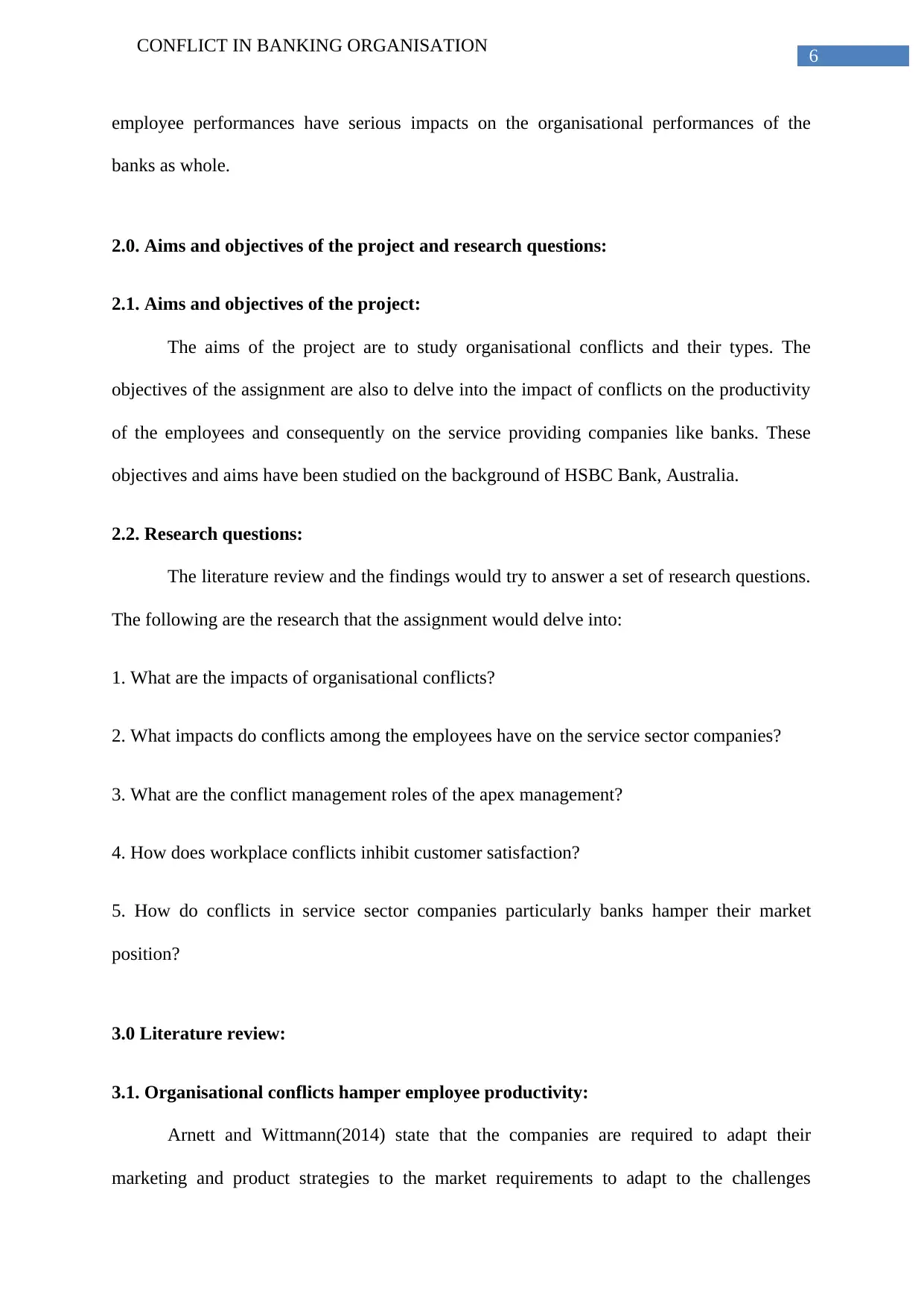
6
CONFLICT IN BANKING ORGANISATION
employee performances have serious impacts on the organisational performances of the
banks as whole.
2.0. Aims and objectives of the project and research questions:
2.1. Aims and objectives of the project:
The aims of the project are to study organisational conflicts and their types. The
objectives of the assignment are also to delve into the impact of conflicts on the productivity
of the employees and consequently on the service providing companies like banks. These
objectives and aims have been studied on the background of HSBC Bank, Australia.
2.2. Research questions:
The literature review and the findings would try to answer a set of research questions.
The following are the research that the assignment would delve into:
1. What are the impacts of organisational conflicts?
2. What impacts do conflicts among the employees have on the service sector companies?
3. What are the conflict management roles of the apex management?
4. How does workplace conflicts inhibit customer satisfaction?
5. How do conflicts in service sector companies particularly banks hamper their market
position?
3.0 Literature review:
3.1. Organisational conflicts hamper employee productivity:
Arnett and Wittmann(2014) state that the companies are required to adapt their
marketing and product strategies to the market requirements to adapt to the challenges
CONFLICT IN BANKING ORGANISATION
employee performances have serious impacts on the organisational performances of the
banks as whole.
2.0. Aims and objectives of the project and research questions:
2.1. Aims and objectives of the project:
The aims of the project are to study organisational conflicts and their types. The
objectives of the assignment are also to delve into the impact of conflicts on the productivity
of the employees and consequently on the service providing companies like banks. These
objectives and aims have been studied on the background of HSBC Bank, Australia.
2.2. Research questions:
The literature review and the findings would try to answer a set of research questions.
The following are the research that the assignment would delve into:
1. What are the impacts of organisational conflicts?
2. What impacts do conflicts among the employees have on the service sector companies?
3. What are the conflict management roles of the apex management?
4. How does workplace conflicts inhibit customer satisfaction?
5. How do conflicts in service sector companies particularly banks hamper their market
position?
3.0 Literature review:
3.1. Organisational conflicts hamper employee productivity:
Arnett and Wittmann(2014) state that the companies are required to adapt their
marketing and product strategies to the market requirements to adapt to the challenges
Paraphrase This Document
Need a fresh take? Get an instant paraphrase of this document with our AI Paraphraser
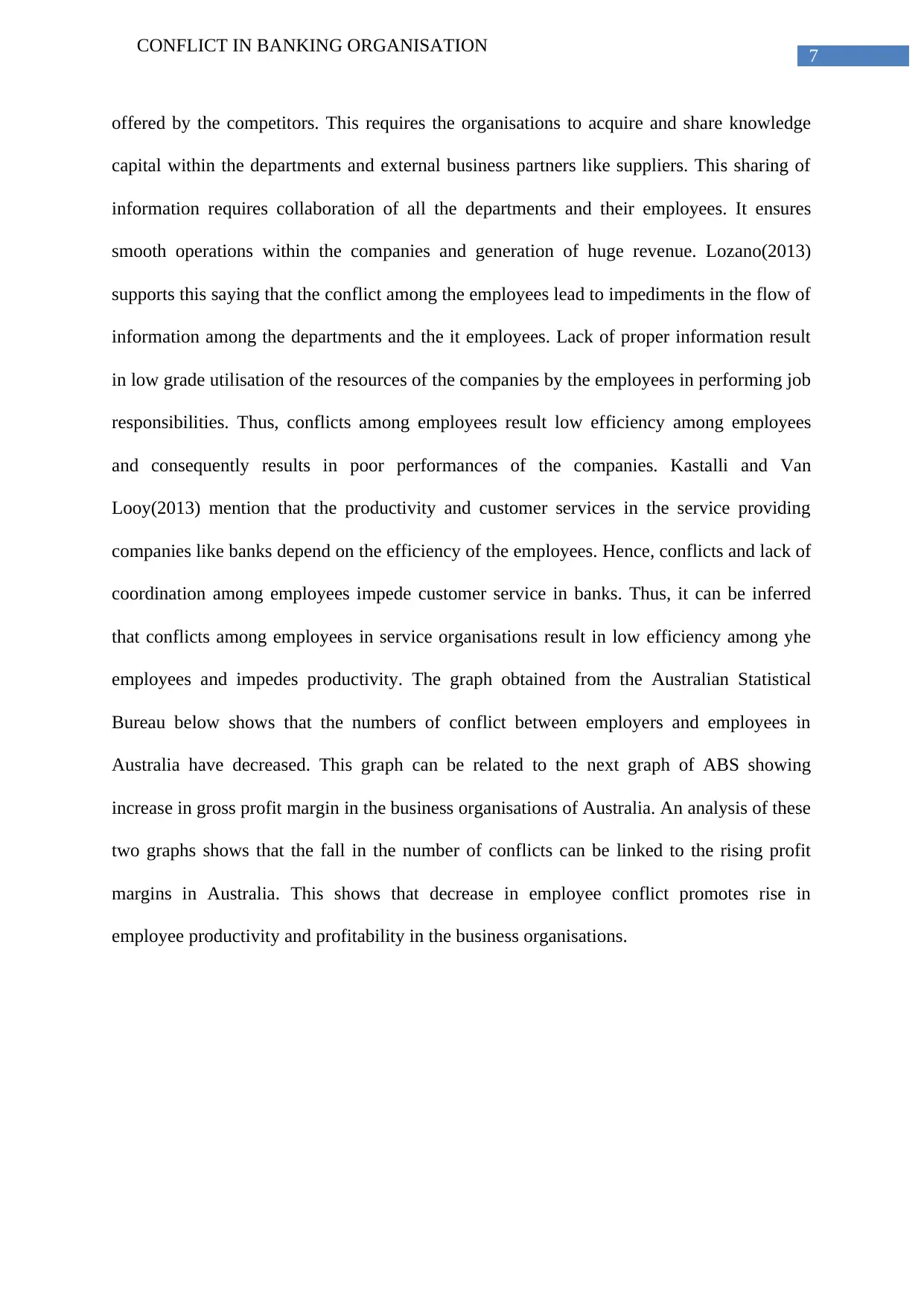
7
CONFLICT IN BANKING ORGANISATION
offered by the competitors. This requires the organisations to acquire and share knowledge
capital within the departments and external business partners like suppliers. This sharing of
information requires collaboration of all the departments and their employees. It ensures
smooth operations within the companies and generation of huge revenue. Lozano(2013)
supports this saying that the conflict among the employees lead to impediments in the flow of
information among the departments and the it employees. Lack of proper information result
in low grade utilisation of the resources of the companies by the employees in performing job
responsibilities. Thus, conflicts among employees result low efficiency among employees
and consequently results in poor performances of the companies. Kastalli and Van
Looy(2013) mention that the productivity and customer services in the service providing
companies like banks depend on the efficiency of the employees. Hence, conflicts and lack of
coordination among employees impede customer service in banks. Thus, it can be inferred
that conflicts among employees in service organisations result in low efficiency among yhe
employees and impedes productivity. The graph obtained from the Australian Statistical
Bureau below shows that the numbers of conflict between employers and employees in
Australia have decreased. This graph can be related to the next graph of ABS showing
increase in gross profit margin in the business organisations of Australia. An analysis of these
two graphs shows that the fall in the number of conflicts can be linked to the rising profit
margins in Australia. This shows that decrease in employee conflict promotes rise in
employee productivity and profitability in the business organisations.
CONFLICT IN BANKING ORGANISATION
offered by the competitors. This requires the organisations to acquire and share knowledge
capital within the departments and external business partners like suppliers. This sharing of
information requires collaboration of all the departments and their employees. It ensures
smooth operations within the companies and generation of huge revenue. Lozano(2013)
supports this saying that the conflict among the employees lead to impediments in the flow of
information among the departments and the it employees. Lack of proper information result
in low grade utilisation of the resources of the companies by the employees in performing job
responsibilities. Thus, conflicts among employees result low efficiency among employees
and consequently results in poor performances of the companies. Kastalli and Van
Looy(2013) mention that the productivity and customer services in the service providing
companies like banks depend on the efficiency of the employees. Hence, conflicts and lack of
coordination among employees impede customer service in banks. Thus, it can be inferred
that conflicts among employees in service organisations result in low efficiency among yhe
employees and impedes productivity. The graph obtained from the Australian Statistical
Bureau below shows that the numbers of conflict between employers and employees in
Australia have decreased. This graph can be related to the next graph of ABS showing
increase in gross profit margin in the business organisations of Australia. An analysis of these
two graphs shows that the fall in the number of conflicts can be linked to the rising profit
margins in Australia. This shows that decrease in employee conflict promotes rise in
employee productivity and profitability in the business organisations.
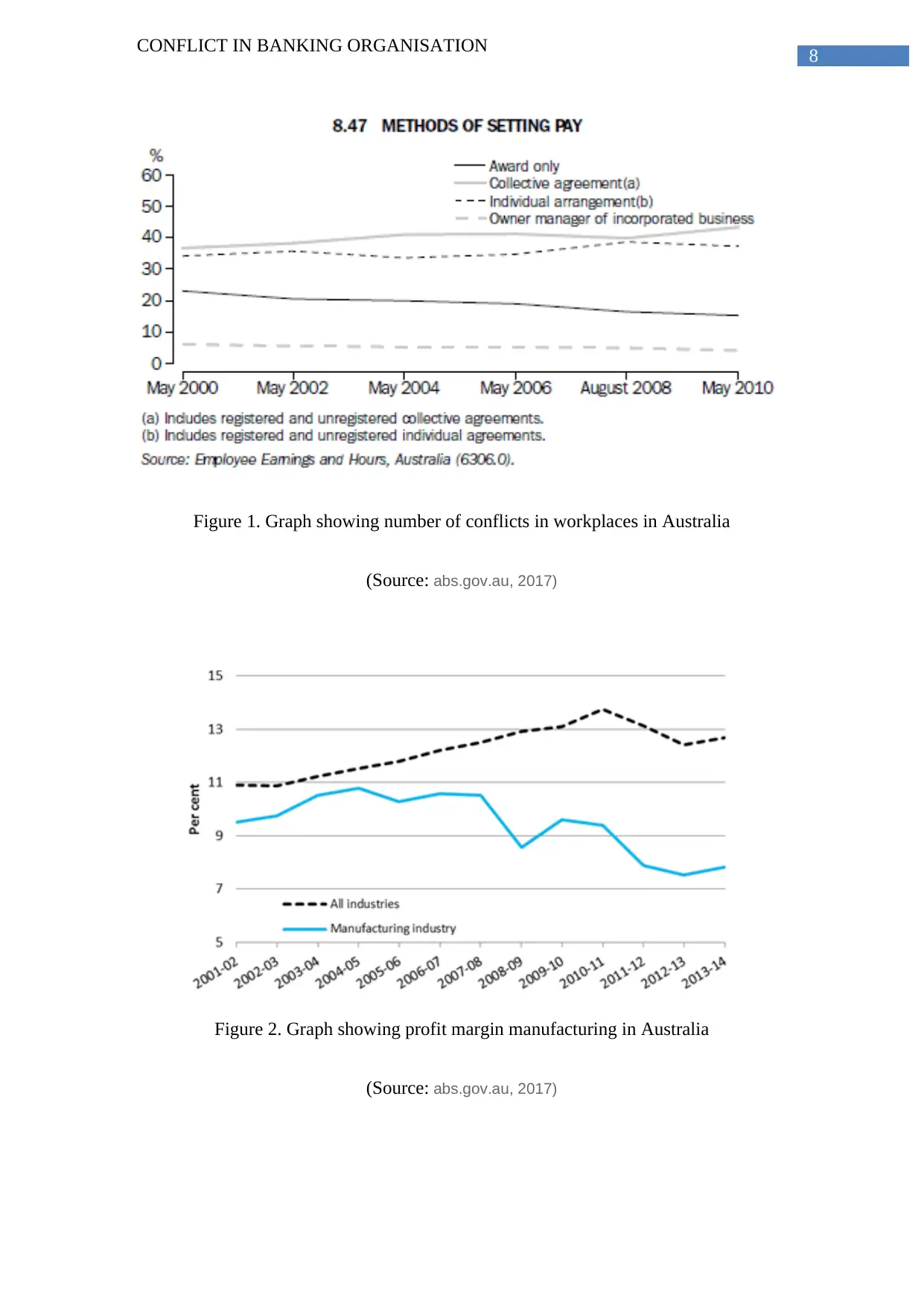
8
CONFLICT IN BANKING ORGANISATION
Figure 1. Graph showing number of conflicts in workplaces in Australia
(Source: abs.gov.au, 2017)
Figure 2. Graph showing profit margin manufacturing in Australia
(Source: abs.gov.au, 2017)
CONFLICT IN BANKING ORGANISATION
Figure 1. Graph showing number of conflicts in workplaces in Australia
(Source: abs.gov.au, 2017)
Figure 2. Graph showing profit margin manufacturing in Australia
(Source: abs.gov.au, 2017)
⊘ This is a preview!⊘
Do you want full access?
Subscribe today to unlock all pages.

Trusted by 1+ million students worldwide
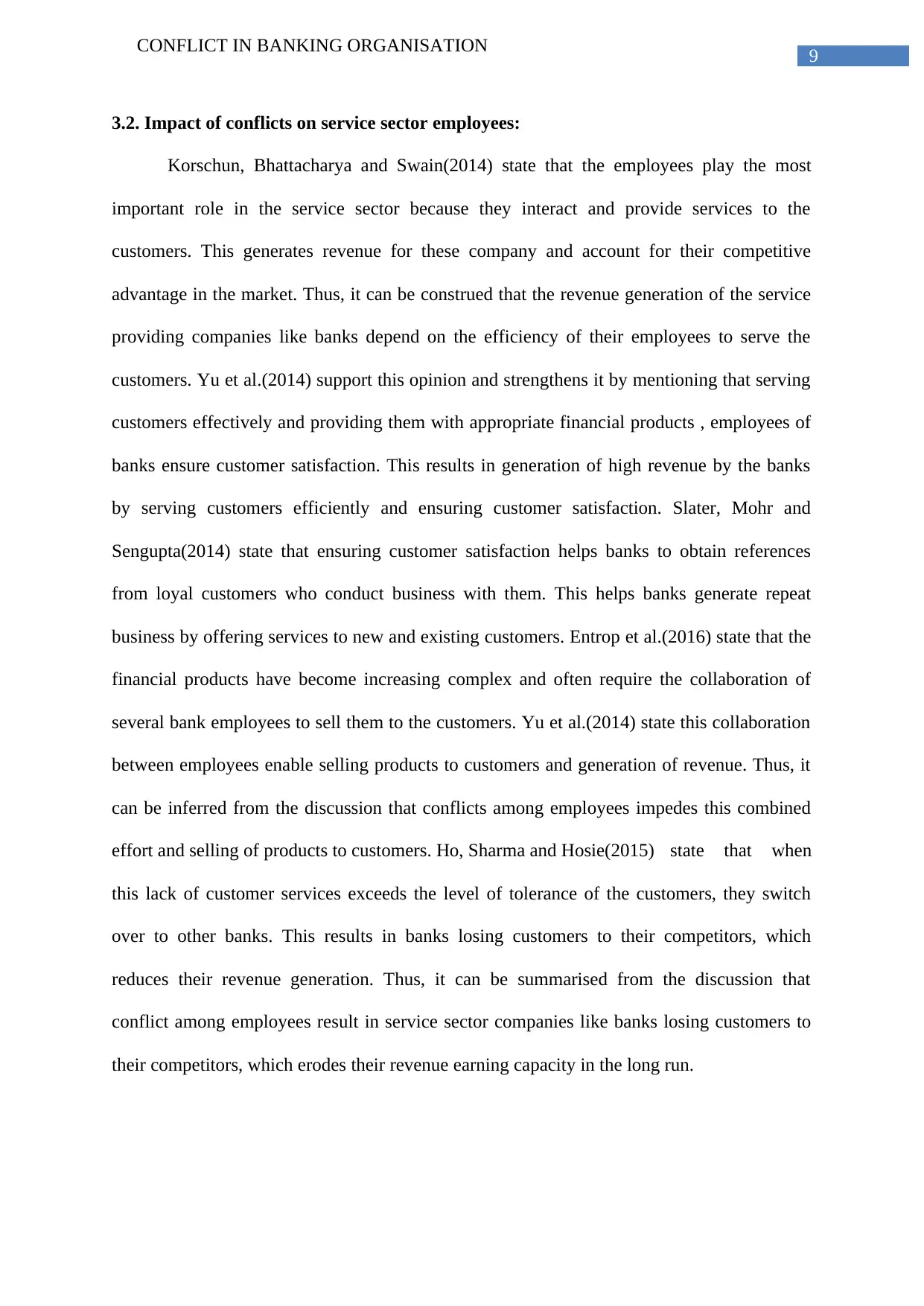
9
CONFLICT IN BANKING ORGANISATION
3.2. Impact of conflicts on service sector employees:
Korschun, Bhattacharya and Swain(2014) state that the employees play the most
important role in the service sector because they interact and provide services to the
customers. This generates revenue for these company and account for their competitive
advantage in the market. Thus, it can be construed that the revenue generation of the service
providing companies like banks depend on the efficiency of their employees to serve the
customers. Yu et al.(2014) support this opinion and strengthens it by mentioning that serving
customers effectively and providing them with appropriate financial products , employees of
banks ensure customer satisfaction. This results in generation of high revenue by the banks
by serving customers efficiently and ensuring customer satisfaction. Slater, Mohr and
Sengupta(2014) state that ensuring customer satisfaction helps banks to obtain references
from loyal customers who conduct business with them. This helps banks generate repeat
business by offering services to new and existing customers. Entrop et al.(2016) state that the
financial products have become increasing complex and often require the collaboration of
several bank employees to sell them to the customers. Yu et al.(2014) state this collaboration
between employees enable selling products to customers and generation of revenue. Thus, it
can be inferred from the discussion that conflicts among employees impedes this combined
effort and selling of products to customers. Ho, Sharma and Hosie(2015) state that when
this lack of customer services exceeds the level of tolerance of the customers, they switch
over to other banks. This results in banks losing customers to their competitors, which
reduces their revenue generation. Thus, it can be summarised from the discussion that
conflict among employees result in service sector companies like banks losing customers to
their competitors, which erodes their revenue earning capacity in the long run.
CONFLICT IN BANKING ORGANISATION
3.2. Impact of conflicts on service sector employees:
Korschun, Bhattacharya and Swain(2014) state that the employees play the most
important role in the service sector because they interact and provide services to the
customers. This generates revenue for these company and account for their competitive
advantage in the market. Thus, it can be construed that the revenue generation of the service
providing companies like banks depend on the efficiency of their employees to serve the
customers. Yu et al.(2014) support this opinion and strengthens it by mentioning that serving
customers effectively and providing them with appropriate financial products , employees of
banks ensure customer satisfaction. This results in generation of high revenue by the banks
by serving customers efficiently and ensuring customer satisfaction. Slater, Mohr and
Sengupta(2014) state that ensuring customer satisfaction helps banks to obtain references
from loyal customers who conduct business with them. This helps banks generate repeat
business by offering services to new and existing customers. Entrop et al.(2016) state that the
financial products have become increasing complex and often require the collaboration of
several bank employees to sell them to the customers. Yu et al.(2014) state this collaboration
between employees enable selling products to customers and generation of revenue. Thus, it
can be inferred from the discussion that conflicts among employees impedes this combined
effort and selling of products to customers. Ho, Sharma and Hosie(2015) state that when
this lack of customer services exceeds the level of tolerance of the customers, they switch
over to other banks. This results in banks losing customers to their competitors, which
reduces their revenue generation. Thus, it can be summarised from the discussion that
conflict among employees result in service sector companies like banks losing customers to
their competitors, which erodes their revenue earning capacity in the long run.
Paraphrase This Document
Need a fresh take? Get an instant paraphrase of this document with our AI Paraphraser
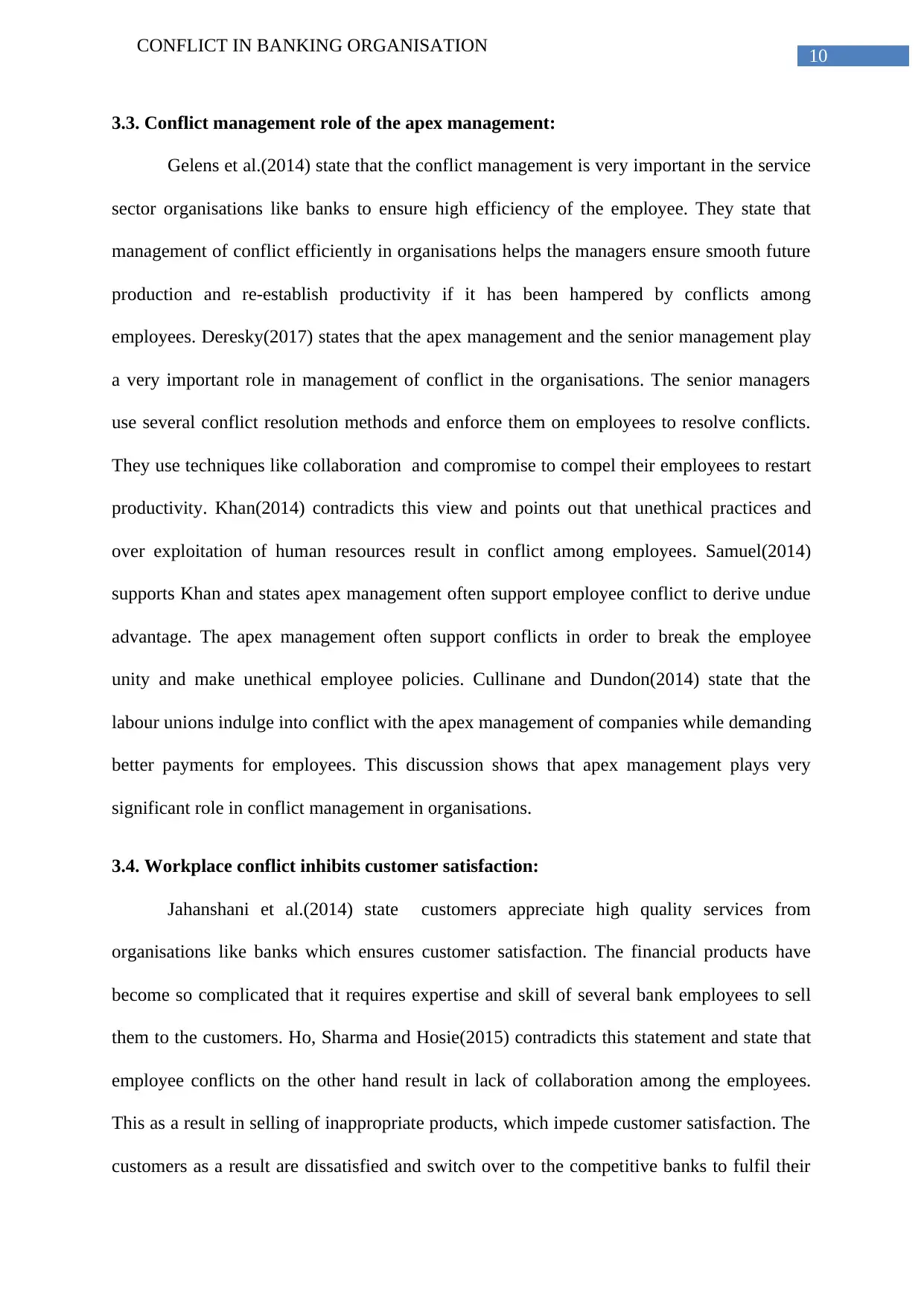
10
CONFLICT IN BANKING ORGANISATION
3.3. Conflict management role of the apex management:
Gelens et al.(2014) state that the conflict management is very important in the service
sector organisations like banks to ensure high efficiency of the employee. They state that
management of conflict efficiently in organisations helps the managers ensure smooth future
production and re-establish productivity if it has been hampered by conflicts among
employees. Deresky(2017) states that the apex management and the senior management play
a very important role in management of conflict in the organisations. The senior managers
use several conflict resolution methods and enforce them on employees to resolve conflicts.
They use techniques like collaboration and compromise to compel their employees to restart
productivity. Khan(2014) contradicts this view and points out that unethical practices and
over exploitation of human resources result in conflict among employees. Samuel(2014)
supports Khan and states apex management often support employee conflict to derive undue
advantage. The apex management often support conflicts in order to break the employee
unity and make unethical employee policies. Cullinane and Dundon(2014) state that the
labour unions indulge into conflict with the apex management of companies while demanding
better payments for employees. This discussion shows that apex management plays very
significant role in conflict management in organisations.
3.4. Workplace conflict inhibits customer satisfaction:
Jahanshani et al.(2014) state customers appreciate high quality services from
organisations like banks which ensures customer satisfaction. The financial products have
become so complicated that it requires expertise and skill of several bank employees to sell
them to the customers. Ho, Sharma and Hosie(2015) contradicts this statement and state that
employee conflicts on the other hand result in lack of collaboration among the employees.
This as a result in selling of inappropriate products, which impede customer satisfaction. The
customers as a result are dissatisfied and switch over to the competitive banks to fulfil their
CONFLICT IN BANKING ORGANISATION
3.3. Conflict management role of the apex management:
Gelens et al.(2014) state that the conflict management is very important in the service
sector organisations like banks to ensure high efficiency of the employee. They state that
management of conflict efficiently in organisations helps the managers ensure smooth future
production and re-establish productivity if it has been hampered by conflicts among
employees. Deresky(2017) states that the apex management and the senior management play
a very important role in management of conflict in the organisations. The senior managers
use several conflict resolution methods and enforce them on employees to resolve conflicts.
They use techniques like collaboration and compromise to compel their employees to restart
productivity. Khan(2014) contradicts this view and points out that unethical practices and
over exploitation of human resources result in conflict among employees. Samuel(2014)
supports Khan and states apex management often support employee conflict to derive undue
advantage. The apex management often support conflicts in order to break the employee
unity and make unethical employee policies. Cullinane and Dundon(2014) state that the
labour unions indulge into conflict with the apex management of companies while demanding
better payments for employees. This discussion shows that apex management plays very
significant role in conflict management in organisations.
3.4. Workplace conflict inhibits customer satisfaction:
Jahanshani et al.(2014) state customers appreciate high quality services from
organisations like banks which ensures customer satisfaction. The financial products have
become so complicated that it requires expertise and skill of several bank employees to sell
them to the customers. Ho, Sharma and Hosie(2015) contradicts this statement and state that
employee conflicts on the other hand result in lack of collaboration among the employees.
This as a result in selling of inappropriate products, which impede customer satisfaction. The
customers as a result are dissatisfied and switch over to the competitive banks to fulfil their
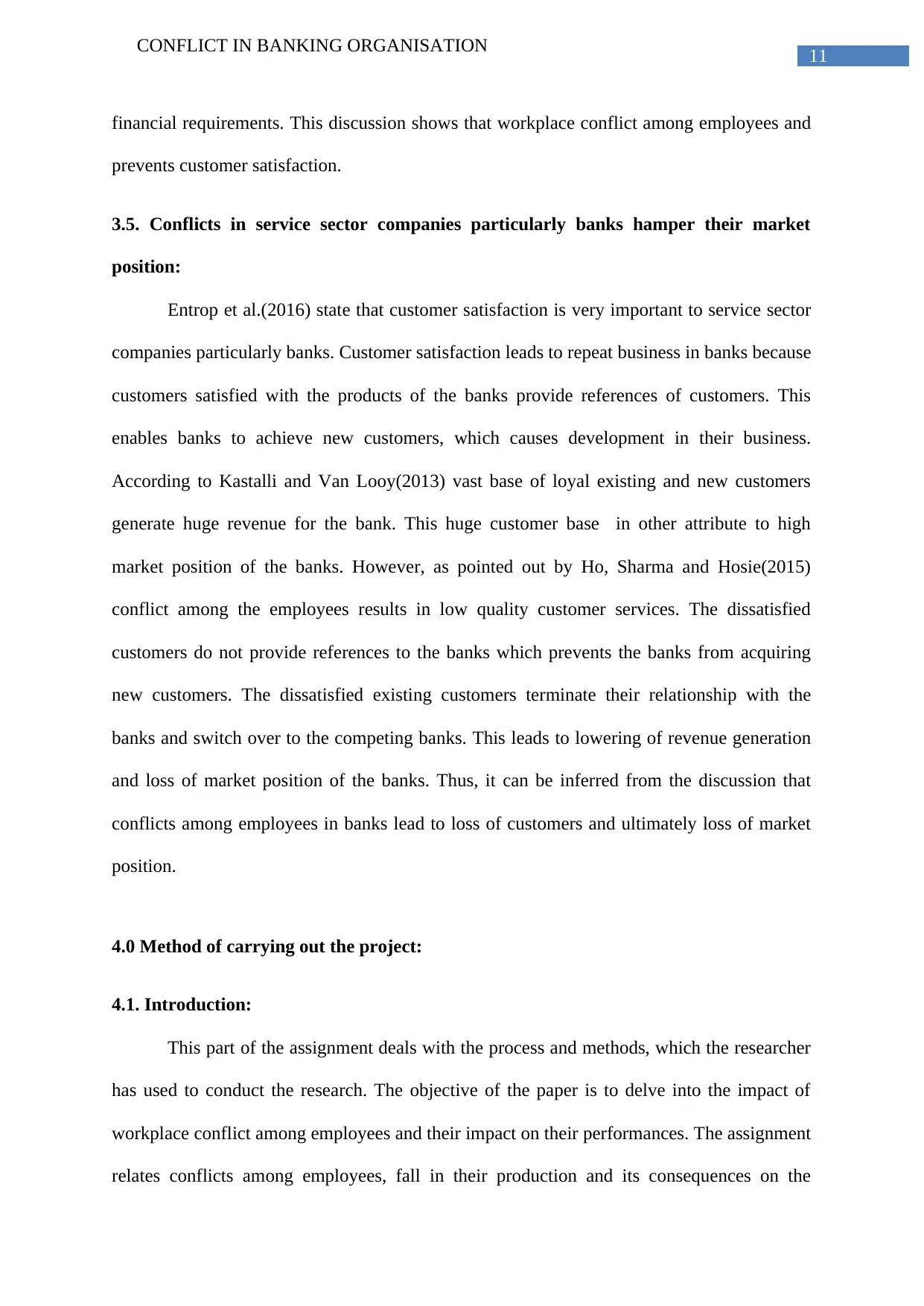
11
CONFLICT IN BANKING ORGANISATION
financial requirements. This discussion shows that workplace conflict among employees and
prevents customer satisfaction.
3.5. Conflicts in service sector companies particularly banks hamper their market
position:
Entrop et al.(2016) state that customer satisfaction is very important to service sector
companies particularly banks. Customer satisfaction leads to repeat business in banks because
customers satisfied with the products of the banks provide references of customers. This
enables banks to achieve new customers, which causes development in their business.
According to Kastalli and Van Looy(2013) vast base of loyal existing and new customers
generate huge revenue for the bank. This huge customer base in other attribute to high
market position of the banks. However, as pointed out by Ho, Sharma and Hosie(2015)
conflict among the employees results in low quality customer services. The dissatisfied
customers do not provide references to the banks which prevents the banks from acquiring
new customers. The dissatisfied existing customers terminate their relationship with the
banks and switch over to the competing banks. This leads to lowering of revenue generation
and loss of market position of the banks. Thus, it can be inferred from the discussion that
conflicts among employees in banks lead to loss of customers and ultimately loss of market
position.
4.0 Method of carrying out the project:
4.1. Introduction:
This part of the assignment deals with the process and methods, which the researcher
has used to conduct the research. The objective of the paper is to delve into the impact of
workplace conflict among employees and their impact on their performances. The assignment
relates conflicts among employees, fall in their production and its consequences on the
CONFLICT IN BANKING ORGANISATION
financial requirements. This discussion shows that workplace conflict among employees and
prevents customer satisfaction.
3.5. Conflicts in service sector companies particularly banks hamper their market
position:
Entrop et al.(2016) state that customer satisfaction is very important to service sector
companies particularly banks. Customer satisfaction leads to repeat business in banks because
customers satisfied with the products of the banks provide references of customers. This
enables banks to achieve new customers, which causes development in their business.
According to Kastalli and Van Looy(2013) vast base of loyal existing and new customers
generate huge revenue for the bank. This huge customer base in other attribute to high
market position of the banks. However, as pointed out by Ho, Sharma and Hosie(2015)
conflict among the employees results in low quality customer services. The dissatisfied
customers do not provide references to the banks which prevents the banks from acquiring
new customers. The dissatisfied existing customers terminate their relationship with the
banks and switch over to the competing banks. This leads to lowering of revenue generation
and loss of market position of the banks. Thus, it can be inferred from the discussion that
conflicts among employees in banks lead to loss of customers and ultimately loss of market
position.
4.0 Method of carrying out the project:
4.1. Introduction:
This part of the assignment deals with the process and methods, which the researcher
has used to conduct the research. The objective of the paper is to delve into the impact of
workplace conflict among employees and their impact on their performances. The assignment
relates conflicts among employees, fall in their production and its consequences on the
⊘ This is a preview!⊘
Do you want full access?
Subscribe today to unlock all pages.

Trusted by 1+ million students worldwide
1 out of 20
Related Documents
Your All-in-One AI-Powered Toolkit for Academic Success.
+13062052269
info@desklib.com
Available 24*7 on WhatsApp / Email
![[object Object]](/_next/static/media/star-bottom.7253800d.svg)
Unlock your academic potential
Copyright © 2020–2025 A2Z Services. All Rights Reserved. Developed and managed by ZUCOL.





